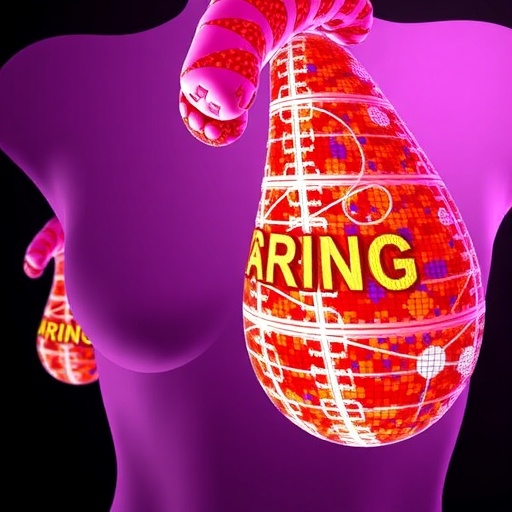In a groundbreaking study published in BMC Cancer, researchers have delved deep into the molecular landscape of endocrine-resistant breast cancer, unveiling key transcriptomic alterations that underpin therapy resistance. This comprehensive investigation focused on patients afflicted with estrogen receptor α–positive (ER-positive) and human epidermal growth factor receptor 2–negative (HER2-negative) breast tumors, a common subtype that frequently undergoes endocrine therapy. Despite initial treatment efficacy, nearly one-third of these patients experience relapse, often with tumors retaining ER expression, challenging conventional therapeutic paradigms.
The researchers stratified their study cohort into two distinct groups to better elucidate mechanisms contributing to resistance. One group included patients who experienced relapse within five years while under continuous endocrine therapy, defined as the endocrine-resistant group. The other cohort consisted of patients who exhibited no disease progression after a decade, classified as endocrine-sensitive. This careful delineation allowed for a clear comparison of transcriptomic and clinical features between tumors that succumbed early to therapy and those that remained controlled long-term.
At the molecular level, gene expression analyses were conducted on RNA extracted from archived tumor specimens preserved within institutional biobanks. This approach enabled the team to capture a high-resolution snapshot of gene activity, offering insights into the biological pathways that distinguish resistant tumors from their sensitive counterparts. Leveraging next-generation sequencing technologies and robust bioinformatics pipelines, the study decoded complex gene expression signatures across the two patient groups.
One of the most striking findings was the elevated expression of cell-cycle genes in the tumors of endocrine-resistant patients at the time of initial diagnosis. These tumors also correlated with higher histological grades and intrinsic molecular subtype risk scores, suggesting that aggressive proliferation and intrinsic tumor biology are key drivers of therapeutic failure. It appears that endocrine resistance is not merely a consequence of treatment but is inherently linked to the tumor’s cellular machinery driving unchecked growth.
In contrast, tumors from endocrine-sensitive patients exhibited gene expression profiles indicative of slower proliferation and more favorable molecular subtypes. These distinctions at baseline underscore the heterogeneity of ER-positive breast cancer and spotlight the importance of precise molecular characterization in guiding treatment decisions. The findings advocate for a more tailored therapeutic approach, recognizing that some tumors are intrinsically predisposed to resist standard endocrine treatments.
The research also provided valuable insights into the dynamic changes occurring at relapse. Comparing transcriptomic data from matched primary and relapsed tumors in resistant patients revealed a shift in gene expression patterns. Notably, genes associated with cellular metabolism were upregulated, while hallmark estrogen-response pathways were downregulated, reflecting adaptive tumor evolution in response to endocrine therapy. This metabolic reprogramming may equip cancer cells with alternative survival strategies independent of estrogen signaling.
Such metabolic rewiring aligns with emerging recognition of cancer as a metabolically plastic disease. Resistant cancer cells appear to harness altered bioenergetics and biosynthetic pathways, enabling them to thrive even in the estrogen-depleted milieu created by endocrine treatments. Targeting these metabolic vulnerabilities could therefore represent a promising avenue for overcoming resistance and improving patient outcomes.
Clinically, the integration of transcriptomic profiles with traditional clinicopathological variables allowed the identification of potential prognostic biomarkers. These markers provide predictive insights into which tumors are likely to develop resistance and might benefit from alternative or combination therapies upfront. Ultimately, this research aims to refine personalized medicine approaches in breast oncology by incorporating detailed molecular diagnostics.
The implications of these findings are far-reaching, especially considering the prevalence of ER-positive breast cancer as the most commonly diagnosed subtype worldwide. Resistance to endocrine therapy represents a major clinical hurdle, accounting for considerable morbidity and mortality. By unraveling the transcriptomic underpinnings of this resistance, the study offers new hope for devising interventions that can preempt or reverse therapeutic failure.
An intriguing aspect of the research was the confirmation that most relapsed tumors retain ER positivity despite therapeutic resistance. This observation challenges the simplistic notion that loss of receptor expression explains treatment failure and points to the complexity of intracellular signaling networks that maintain oncogenic activity beyond estrogen dependency. It suggests that resistance encompasses both genomic and epigenomic alterations modulating receptor function and downstream pathways.
The study employed state-of-the-art analytical frameworks such as gene set enrichment analysis to discern pathway-level changes, highlighting upregulated cell cycle and metabolic gene sets in resistant tumors. These tools allow researchers to not only catalog differentially expressed genes but also interpret their biological significance in the context of coordinated cellular processes.
Moreover, this research underscores the vital role of archived tumor biobanks and longitudinal patient data in cancer research. Access to high-quality, well-annotated tissue samples is indispensable for advancing our understanding of cancer biology and therapy response. Integration with clinical outcomes enables translational insights with real-world applicability.
Looking ahead, the authors advocate for further validation of these transcriptomic signatures in larger, independent cohorts and for the development of clinical assays that can be routinely implemented. Such diagnostic tools could empower oncologists to stratify patients more accurately and design therapeutic regimens that circumvent endocrine resistance.
The study represents a paradigm shift in breast cancer research, focusing on the interplay between tumor biology and therapeutic pressure. By illuminating the transcriptomic trajectories that define resistance, the findings pave the way for novel therapeutic strategies targeting not only estrogen signaling but also cell cycle regulators and metabolic pathways.
In summary, this landmark investigation offers a detailed molecular blueprint of endocrine resistance in ER-positive breast cancer, blending clinical data with cutting-edge transcriptomic analysis. It highlights the heterogeneity inherent in tumor behavior, the adaptive capacity of cancer cells, and the promise of personalized, biology-driven treatment approaches. As the oncology community grapples with overcoming resistance, such comprehensive molecular portraits will be invaluable in guiding next-generation therapies and improving patient survival.
Subject of Research: Transcriptomic analysis of endocrine-resistant ER-positive, HER2-negative breast cancer
Article Title: Transcriptomic profiles of endocrine-resistant breast cancer
Article References:
Schagerholm Stanev, C., Sifakis, E.G., Hases, L. et al. Transcriptomic profiles of endocrine-resistant breast cancer. BMC Cancer 25, 1556 (2025). https://doi.org/10.1186/s12885-025-14826-1
Image Credits: Scienmag.com
DOI: https://doi.org/10.1186/s12885-025-14826-1




